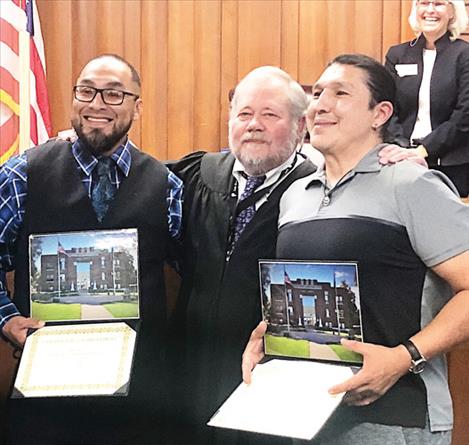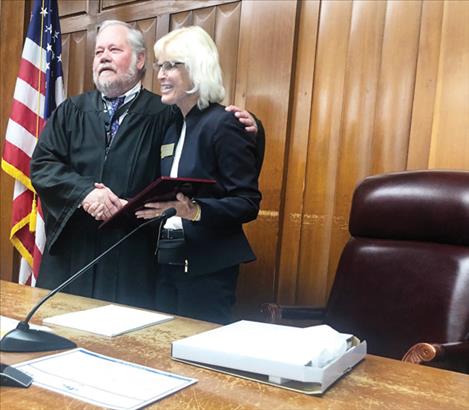Judge Manley retires from drug court
Hey savvy news reader! Thanks for choosing local.
You are now reading
1 of 3 free articles.
LAKE COUNTY — Judge Jim Manley’s next to last drug court was both raucous and poignant, a celebration and a farewell. It was also a testimonial to how the justice system, working in concert with a supportive community, can transform lives.
Supreme Court Justice Ingrid Gustafson – a former district judge in Yellowstone County who established one of the first adult treatment courts in the state – was on hand to watch the proceedings. She also presented Manley, who retires May 31 after nine years on the bench, with a plaque from the High Court, honoring his “great achievements, considerable hard work and dedication.”
Also on hand were the four candidates for his job – attorneys Ben Anciaux, Kathryn McEnery, Molly Owen and Alisha Rapkoch. Gov. Gianforte is expected to name his replacement this week.
Manley, who credits Gustafson with helping him launch the 20th Judicial District Drug Court, stressed to the would-be judges the importance of community support, as evidenced by the enthusiastic crowd in the courtroom May 19.
“The most important thing, the most effective thing is I watch people become part of a new community. I see people coming together and helping each other and wanting to look good in each other’s eyes,” he said.
During the past decade, he’s witnessed the local recovery community flourish from a handful of people to more than 300. “Now, it’s cool to be in recovery.”
According to Judge Gustafson, the same outcomes are visible across Montana, which is now home to 31 district drug courts and five tribal drug courts. It’s a movement often spearheaded by judges, who see people with substance abuse disorders again and again in their courtrooms.
“You really feel like you’re part of the problem because you’re churning people through the judicial system and not getting them the assistance they need to really turn their lives around.”
While drug court can be demanding, as a district judge “you’re putting in a lot of time anyway” with often discouraging results, says Gustafson. “I’d rather put in extra time at the front end to see somebody do better and not come back again.”
She started a felony drug court in Yellowstone County – the state’s largest and most populous judicial district – and between May 2008 and October 2020, they’ve tracked significant improvements in families’ lives. Among participants, the court saw a 40% increase in the number of adults getting valid driver’s licenses and a 55% jump in the amount of education their children received, and of the 220 babies born to participants, 91.6% were born drug free.
In Manley’s courtroom those statistics were translated into life experiences. Danny, sober for 1,054 days, has custody of his 4-year-old daughter and works at KwaTaqNuk; Angie has 1,243 days of sobriety under her belt, will complete her bachelor’s degree in social work next year, and serves as assistant drug court coordinator. Juanita, who was a meth addict for 29 years, has been sober for two years and 10 months, will graduate in June with an associate degree in chemical dependency counseling, and is the house mother for the women’s sober living center in Ronan.
Two men – Patrick Matt and Alex Finley – graduated from Drug Court May 19, and each was introduced by Judge Manley before sharing their stories.
Matt, a performing artist and community activist, told attendees that there’s often talk of the need for a drug treatment center on the Flathead Reservation. “Prior to my participation in drug court, I did not know there were so many people in the fight for sobriety, and that there were people, walking it out day in and day out, really making a difference,” he said. “What I’ve realized is every person in this room that’s part of drug court is a walking treatment center.”
The program itself demanding and transformative, and he called the leadership “exemplary.”
“One of the best things is that you do it alongside people who are walking it out – just like you – people who have taken the journey before.”
Manley introduced Finley as “maybe the toughest guy I know, but he may have also had the toughest upbringing of anybody I know.”
Finley explained that he’s been in and out of the court system for two decades, since he turned 18. “A lot of us Native people felt we were just thrown to the wolves back then, locked up and the key thrown away.”
But drug court has helped him turn his life around and resume responsibility for his six children. “I wouldn’t have my kids, I wouldn’t have my family and I probably wouldn’t have my life if it weren’t for Judge Manley and this program,” he said.
“I’ve embraced it with everything that I am, to change, to be an example, and not just for my kids but for the ones who are struggling and don’t think they can make it.”
“Honestly, if I can do this, you all can do this,” he added. “Believe in yourself because you’re worth it, and drug court and the people in it do care. You have all the support you need in this program.”
As a Native, Finley grew up feeling “like we were not given a fair chance at all in this community – our own home, our own land.” His experience with drug court gave him that chance. Those who succeed “have proved that we are worth it, that our families are worth it, that we can do it and that we can be great citizens of our own community.”
Gustafson, who visits drug courts across the state, says that while each has “its own character and differences, they all develop a really strong community with participants. You have to hold people accountable, but you’re also empowering them to change their lives and engage with other people who have walked the same journey.”
She advises Manley’s successor to first recognize that people with substance abuse disorders are dealing with a disease, and often relapse. “You have to expect that, work through that and teach them about their disease so that they can manage it.”
Unlike in a standard courtroom, judges also need to directly engage with participants. “You get much better results if you spend at least three minutes talking to them and interacting with them,” she advises.
“It’s still a courtroom and we’re still doing important work in here, but the work we’re doing and how we’re doing it is just slightly different.”
She expressed admiration for the cultural component of Lake County’s program and how it’s helped build such a vibrant recovery community for Native Americans. She also noted that several people attending drug court had yet to be formally inducted. “It tells me that the recovery community is reaching out to people who have problems and they’re seeing court as a resource.”
“It’s wonderful to come here and see that,” she added. “We’re definitely going to miss Judge Manley.”

















